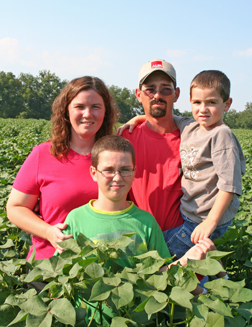OYFF: Cotton Crop Gives Family Hope For The Future Of Smith Farms

It was a tale of two crops — one, corn; the other, cotton. One made Matthew Smith dread going to work; the other kept him going.Such was the quandary Matthew found himself in last year when the rains didn’t come, the fields turned brittle and brown and some farmers simply gave up hope … or farming altogether.”It was hard to go to work. Normally, I get up and I’m looking forward to what I’ve got laid out for the day to do. But last year, it was just hard to find anything to get excited about,” Matthew said of his failed 2007 corn crop, which made less than half its normal yield of 150 bushels per acre. “At places, we got only 50 bushels, and the most was 75 and 80 bushels to the acre. We even cut some for silage. It was that bad. … you could walk 10 feet down a row and not find an ear.”Fortunately for Matthew, the cotton fields came through despite the drought, fetching about 700 pounds per acre and giving him a glimmer of hope.
“You feel better whenever you’re looking at a crop that’s growing and you can just see it growing. It makes you feel like working,” said Matthew who, along with wife Stacey and sons Colby (9) and Micheal (6) are the Alabama Farmers Federation’s Outstanding Young Farm Family in the Cotton Division. “But whenever your crop is just standing there dying and you can’t do anything about it, it’s hard to get excited about working.”Of course, dry land corn is still in the mix at the Smiths’ Calhoun County farm, but Matthew’s dad draws that assignment now. Matthew, meanwhile, handles the wheat, soybeans and cotton.
“I’m mainly in the cotton, and my dad does mostly the corn,” Matthew says, adding they’ve increased their cotton acreage from 250 to 285 this season. “This year’s cotton is looking better than last year’s. Two years ago, one of our farms averaged 1,400 pounds an acre. In 2001, the first year we planted cotton, we had some ground that went over 1,500 pounds per acre, and it was a wet year.”It’s no surprise then that Matthew is bucking the trend by favoring cotton over corn. Earlier this spring, one-time King Cotton was projected to decline 25 percent to 300,000 acres statewide — the least since 1983.”Cotton’s in my rotation, and I’m going to keep it in my rotation,” Matthew vowed. “Since I’ve started growing cotton, some of our farms haven’t seen an acre of corn. I need more cotton acres.”
But finding more acres becomes increasingly difficult with each passing year. “Last year, I lost 40 acres, and it’s in an area where they are putting up houses left and right,” said Matthew.On top of shrinking farmland, he looks at fertilizer for $1,000 per ton, diesel at more than $4 a gallon and wonders whether his sons, both of whom show 4-H market hogs, will be able to follow in his footsteps.”I’d like for them to go into agriculture, but they may have to go into something like the chicken business — it doesn’t take as many acres to grow chickens as it does a herd of cows.”
Stacey, who has worked with Attention Deficit Disorder students at the Calhoun Cleburne Mental Health Center since 1997, dreams of the day when she also can remain at home on the farm.”I feel like my place is here helping Matthew if I need to,” she said. “He has to pay somebody to pack the cotton, but if I wasn’t working, he wouldn’t have to pay somebody.”When it comes to helping out on the farm, Stacey’s no slacker. “I’ve packed cotton; I’ve raked hay; I’ve done just about all of it,” she said. “I was in the field raking hay when I was pregnant with Colby and didn’t know it. … The next day, we got up and were unloading square bales that we had baled up, and I was about a week or two pregnant with him. I was out there on the tractor, pregnant. So, needless to say, that’s where Colby loves to be.”What’s more, Matthew adds, “The day she went into labor, we had a calf that was sick. And my dad was sick with the chicken pox. So she was out there in the catch pen, helping me catch a calf. She didn’t tell me she was in labor, but she was. … 36 hours later, Colby was born.”
